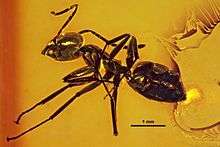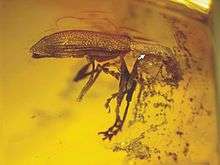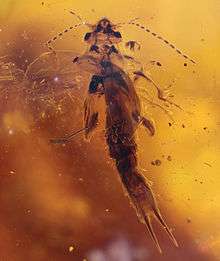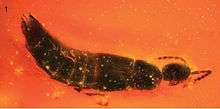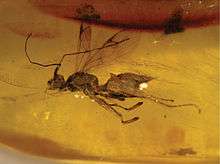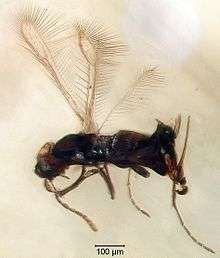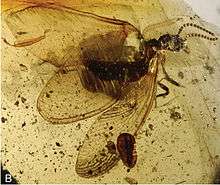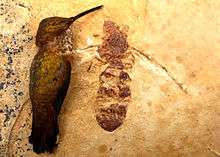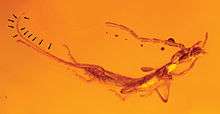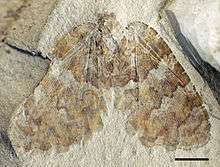2011 in paleontology
| |||
|---|---|---|---|
| Wikimedia Commons has media related to 2011 in paleontology. |
Paleontology or palaeontology (from Greek: paleo, "ancient"; ontos, "being"; and logos, "knowledge") is the study of prehistoric life forms on Earth through the examination of plant and animal fossils.[1] This includes the study of body fossils, tracks (ichnites), burrows, cast-off parts, fossilised feces (coprolites), palynomorphs and chemical residues. Because humans have encountered fossils for millennia, paleontology has a long history both before and after becoming formalized as a science. This article records significant discoveries and events related to paleontology that occurred or were published in the year 2011.
Nematoda
| Name | Novelty | Status | Authors | Age | Unit | Location | Notes | Images |
|---|---|---|---|---|---|---|---|---|
|
Gen et sp nov |
valid |
Poinar |
Diplogasteridae Nematode, parasite of Azteca genus ants |
|||||
Lobopods
| Name | Novelty | Status | Authors | Age | Unit | Location | Notes | Images |
|---|---|---|---|---|---|---|---|---|
|
Valid |
Liu et al. |
Lower Cambrian |
A lobopodian. |
|||||
|
Valid |
Gamez Vintaned, Linan, & Zhuravlev |
Early Cambrian |
A lobopodian. |
|||||
|
Valid |
Dzik |
Early Cambrian |
Sinsk Formation |
A lobopodian. |
||||
Vetulicolians
| Name | Novelty | Status | Authors | Age | Unit | Location | Notes | Images |
|---|---|---|---|---|---|---|---|---|
|
gen. nov |
valid |
Zinther, et al. |
earliest known vetulicolian described |
 Artist's reconstruction | ||||
Molluscs
Arthropods
Arachnids
| Name | Novelty | Status | Authors | Age | Unit | Location | Notes | Images |
|---|---|---|---|---|---|---|---|---|
|
Acarus indicus[5] |
Sp. nov |
Valid |
Kumar et al. |
Early Permian |
Manjir Formation |
A mite. |
||
|
sp nov |
Selden, Shih & Ren |
largest fossil spider described. |
||||||
Crustaceans
| Name | Novelty | Status | Authors | Age | Unit | Location | Notes | Images |
|---|---|---|---|---|---|---|---|---|
|
Dynamenella miettoi[8] |
Sp. nov |
Valid |
De Angeli & Lovato |
Eocene (Lutetian) |
An isopod belonging to the family Sphaeromatidae. |
|||
Insects
| Name | Novelty | Status | Authors | Age | Unit | Location | Notes | Images |
|---|---|---|---|---|---|---|---|---|
|
sp nov |
valid |
Only snakefly from the Green River Formation |
||||||
|
Comb nov |
valid |
Fossil Dolichoderin ant |
| |||||
|
Gen et sp nov |
valid |
Yunakov & Kirejtshuk |
Monotypic broad-nosed weevil genus, one species A. groehni |
| ||||
|
Subfam, Gen et sp nov |
valid |
Monotypic earwig subfamily, one species A. ethirosomatia |
| |||||
|
sp nov |
valid |
Mey |
the second species in Baltimartyria |
|||||
|
sp nov |
Valid |
Guglielmino & Olmi |
A dryinid wasp. |
| ||||
|
sp nov |
valid |
Chatzimanolis & Engel |
first valid Staphylininae species from the fossil record |
|||||
|
sp nov |
valid |
Olmi & Guglielmino |
second fossil Dryinus lamellatus group species |
|||||
|
sp nov |
valid |
Jepsen, Ansorge, & Jarzembowski |
A mesoraphidiid snakefly, one species Iberoraphidia dividua |
|||||
|
sp nov |
valid |
Bechly & Wolf-Schwenninger |
Upper Neocomian |
A mesoraphidiid snakefly, one species Lebanoraphidia nana |
||||
|
sp. |
Valid |
Shi, Liu, & Ren |
Middle Jurassic |
|||||
|
sp. |
Valid |
Liu, Shi, & Ren |
Middle Jurassic |
the smallest species known in the family Grammolingiidae |
||||
|
sp. |
Valid |
Shi, Yang, & Ren |
Middle Jurassic |
|||||
| Mickoleitia longimanus[21] |
ord., fam., gen. et sp. |
valid |
Staniczek, Bechly, & Godunko |
Lower Cretaceous |
A new genus in the new family Mickoleitiidae and a new insect order Coxoplectoptera. |
|||
|
gen et sp nov |
valid |
Huber |
oldest mymarid described |
|||||
|
Gen et sp. nov |
vaild |
Cambay amber |
A Termitid termite |
| ||||
|
gen et sp. |
valid |
Szwedo |
Oise amber |
Second fossil lophopid planthopper from Europe |
||||
|
Sp. nov |
vaild |
Cambay amber |
A Stylotermitid termite |
| ||||
|
Platyperla marquati[25] |
Species |
Valid |
Gallego et al. |
Late Triassic |
A platyperlid stonefly, a species of Platyperla. |
|||
|
fam, gen et sp. |
vaild |
Brothers |
sister genus to Plumariidae |
|||||
|
sp nov |
valid |
Dlussky & Radchenko |
Scandinavian amber |
A fossil ant |
||||
|
Gen et sp. nov |
vaild |
Cambay amber |
A Stylotermitid termite |
| ||||
|
Gen. et sp. |
Valid |
Nel & Delfosse |
||||||
|
Sp nov |
vaild |
Poinar |
A termitaphidid termite bug |
|||||
| Titanomyrma lubei[29] |
Gen. et sp. |
valid |
Archibald, Johnson, Mathewes, & Greenwood |
Green River Formation USA |
new genus for the largest known ants |
|||
|
Gen et sp. nov |
Valid |
Oldest member of the family Diplatyidae |
| |||||
|
Gen et sp. nov |
Valid |
Peng, Makarkin, Wang, & Ren |
A psychopsid silky lacewing, only species U. alexi |
| ||||
|
Gen et sp. nov |
vaild |
Engel & Singh |
Cambay amber |
A Rhinotermitid termite |
| |||
Fishes
Amphibians
Newly named lepospondyls
| Name | Novelty | Status | Authors | Age | Unit | Location | Notes | Images |
|---|---|---|---|---|---|---|---|---|
|
Gen. et sp. |
Valid |
|
Viséan |
A microsaur. |
||||
|
Gen. et sp. |
Valid |
|
Early Permian |
An ostodolepid. | ||||
Newly named temnospondyls
| Name | Novelty | Status | Authors | Age | Unit | Location | Notes | Images |
|---|---|---|---|---|---|---|---|---|
|
Species |
Valid |
|
Early Permian |
A trematopid. |
||||
|
Gen. et sp. |
Valid |
|
early-middle Anisian |
Catalonian basin |
||||
|
Gen. et sp. |
Valid |
|
Early Permian |
A trematopid. |
||||
|
Gen. et sp. |
Valid |
|
Early Permian |
An amphibamid. |
 Rubeostratilia texensis. | |||
Newly named lissamphibians
| Name | Novelty | Status | Authors | Age | Unit | Location | Notes | Images |
|---|---|---|---|---|---|---|---|---|
|
Gen. et sp. |
Valid |
|
Bathonian |
A basal stem salamander. |
||||
Basal reptiles
Newly named captorhinids
| Name | Novelty | Status | Authors | Age | Unit | Location | Notes | Images |
|---|---|---|---|---|---|---|---|---|
|
Gen. et sp. |
Valid |
Middle Permian |
A moradisaurine captorinid. |
|||||
Newly named basal diapsids
| Name | Novelty | Status | Authors | Age | Unit | Location | Notes | Images |
|---|---|---|---|---|---|---|---|---|
|
Gen. et sp. |
Valid |
|
Sakmarian |
The oldest and most basal neodiapsid. |
||||
Newly named ichthyosaurs
| Name | Novelty | Status | Authors | Age | Unit | Location | Notes | Images |
|---|---|---|---|---|---|---|---|---|
|
Gen. et sp. |
Valid |
|
Barremian |
An ophthalmosaurid. |
||||
Lepidosauromorphs
Newly named saurosphargids
| Name | Novelty | Status | Authors | Age | Unit | Location | Notes | Images |
|---|---|---|---|---|---|---|---|---|
|
Gen. et sp. |
Valid |
|
Middle Anisian |
An incertae sedis. |
||||
Newly named sauropterygians
| Name | Novelty | Status | Authors | Age | Unit | Location | Notes | Images |
|---|---|---|---|---|---|---|---|---|
|
Gen. et sp. |
Valid |
|
Late Hauterivian |
An aristonectid. |
||||
|
Gen. et sp. |
Valid |
|
Middle Anisian |
A relative of nothosauroids.[44] | ||||
|
Gen. et sp. |
Valid |
|
Middle Anisian |
A keichousaurid pachypleurosaur. | ||||
|
Species |
Valid |
|
Early Toarcian |
Whitby Limestone Formation |
A second species of Hauffiosaurus. | |||
|
Gen. et sp. |
Valid |
|
Callovian |
A pliosaurid. | ||||
|
Gen. et sp. |
Valid |
|
Pliensbachian |
A plesiosaurid plesiosaur. | ||||
|
Gen. et sp. |
Valid |
|
Maastrichtian |
An elasmosaurid plesiosaur. | ||||
Newly named lizards
| Name | Novelty | Status | Authors | Age | Unit | Location | Notes | Images |
|---|---|---|---|---|---|---|---|---|
|
Gen. et sp. |
Valid |
|
Turonian/Santonian |
An iguanian lizard. |
||||
|
Gen. et sp. |
Valid |
|
Lutetian |
An amphisbaenian lizard. | ||||
|
Gen. et sp. |
Valid |
|
Campanian |
A plioplatecarpine mosasaur. Its type species is Latoplatecarpus willistoni; "Plioplatecarpus" nichollsae (Cuthbertson et al.., 2007) is a second species of Latoplatecarpus. | ||||
|
Gen. et sp. nov |
Valid |
|
Eocene (Chadronian) |
A member of Corytophanidae. The type species is Oreithyia oaklandi. | ||||
|
Gen. et comb. |
Valid |
|
Middle Coniacian to middle Santonian. |
A plioplatecarpine mosasaur, a new genus for "Clidastes" planifrons (Cope, 1874). | ||||
|
Queironius[53] |
Gen. et sp. nov |
Valid |
|
Eocene (Chadronian) |
A relative of the desert iguana. The type species is Queironius praelapsus. | |||
|
Sauropithecoides[53] |
Gen. et comb. nov |
Valid |
|
Eocene (Chadronian) |
A member of Polychrotidae; a new genus for "Polychrus" charisticus Smith (2006). | |||
Newly named snakes
| Name | Novelty | Status | Authors | Age | Unit | Location | Notes | Images |
|---|---|---|---|---|---|---|---|---|
|
Species |
Valid |
|
Late Cretaceous |
A madtsoiid snake. |
||||
Turtles
Newly named turtles
| Name | Novelty | Status | Authors | Age | Unit | Location | Notes | Images |
|---|---|---|---|---|---|---|---|---|
|
Gen. et sp. |
Valid |
|
Early Oligocene |
A podocnemidid. |
||||
|
Gen. et comb. |
Valid |
|
Early Miocene |
A podocnemidid, a new genus for "Shweboemys" gaffneyi. |
||||
|
Gen. et comb. |
Valid |
|
Late Eocene |
Qasr el-Sagha beds |
A podocnemidid, a new genus for "Podocnemis" antiqua. |
|||
|
Gen. et comb. |
Valid |
|
Maastrichtian |
A softshell turtle, new genus for "Aspideretes" lancensis (Gilmore, 1928). |
||||
|
Graptemys kerneri[58] |
Sp. nov |
Valid |
|
Late Pleistocene |
||||
|
Gen. et sp. |
Valid |
|
Oxfordian |
Lorente Formation |
A paracryptodire or a basal testudine. |
|||
|
Species |
Valid |
|
Maastrichtian |
A kinosternoid, a species of Hoplochelys. |
||||
|
Gen. et comb. |
Valid |
|
Paleocene |
Santa Lucía Formation |
A podocnemidid, a new genus for "Roxochelys" vilavilensis. |
|||
|
Gen. et sp. |
Valid |
|
Uncertain, possibly Miocene. |
Uncertain, possibly Moghara Formation. |
A podocnemidid. |
|||
|
Gen. et sp. |
Valid |
|
Early Miocene |
Moghara Formation |
A podocnemidid. |
|||
|
Gen. et comb. |
Valid |
|
Miocene |
A podocnemidid, a new genus for "Sternothaerus" blanckenhorni. |
||||
|
Oliveremys[61] |
Gen. et comb. nov. |
Valid |
|
Eocene |
A trionychid, a new genus for "Trionyx" uintaensis. |
|||
|
Gen. et sp. |
Valid |
|
Campanian - Maastrichtian |
|||||
|
Gen. et sp. |
Valid |
|
Late Cretaceous |
A podocnemidid. |
||||
|
Gen. et sp. |
Valid |
|
Late Cretaceous |
A podocnemidid. |
||||
|
Species |
Valid |
|
Aptian/Albian |
The oldest known chelid, a species of Prochelidella. |
||||
|
Gen. et sp. |
Valid |
|
Upper Kimmeridgian |
Lusitanian Basin |
||||
|
Gen. et sp. |
Valid |
|
Maastrichtian |
A pleurodiran. |
||||
|
Species |
Valid |
|
Middle Eocene |
A species of Trionyx sensu lato. |
||||
|
Wilburemys[67] |
Gen. et sp. nov |
Valid |
|
Late Miocene-Pliocene (Hemphillian-Blancan) |
A member of Emydidae belonging to the subfamily Emydinae. The type species is Wilburemys yakimensis. |
|||
Archosauromorphs
Newly named basal archosauromorphs
| Name | Novelty | Status | Authors | Age | Unit | Location | Notes | Images |
|---|---|---|---|---|---|---|---|---|
|
Gen. et sp. |
Valid |
|
Late Ladinian/Early Carnian |
A doswelliid. |
| |||
|
Gen. et sp. |
Valid |
|
Early Triassic |
The earliest tanystropheid. |
||||
|
Gen. et sp. |
Valid |
|
Late Ladinian/Early Carnian |
The earliest drepanosaurid. |
||||
|
Gen. et comb. |
Valid |
|
Middle - Late Triassic |
A tanystropheid, a new genus for "Tanystropheus" antiquus (von Huene, 1905). |
||||
Archosaurs
Synapsids
Newly named non-mammalian synapsids
| Name | Novelty | Status | Authors | Age | Unit | Location | Notes | Images |
|---|---|---|---|---|---|---|---|---|
|
Sp. |
Valid |
|
Late Permian |
|||||
|
Gen. et comb. |
Valid |
|
Late Permian |
A dicynodont. A new genus for "Dicynodon" woodwardi. |
||||
|
Gen. et sp. |
Valid |
|
Early Jurassic |
|||||
|
Gen. et sp. |
Valid |
|
Middle Triassic |
A carnivorous cynodont. |
||||
|
Gen. et sp. |
Valid |
|
Late Gzhelian |
Remigiusberg Formation |
A sphenacodontid pelycosaur. The type species is Cryptovenator hirschbergeri. |
|||
|
Gen. et comb. |
Valid |
|
Late Permian |
A dicynodont. A new genus for "Dicynodon" bathyrhynchus. |
||||
|
Gen. et comb. |
Valid |
|
Grès Rouge Group |
A large caseid. A new genus for "Casea" rutena. |
||||
|
Gen. et sp. |
Valid |
|
Late Permian |
A therocephalian. |
||||
|
Gen. et comb. |
Valid |
|
Late Permian |
A dicynodont. A new genus for "Dicynodon" benjamini. |
||||
|
Gen. et sp. |
Valid |
|
Late Permian |
A therocephalian. |
||||
|
Gen. et sp. |
Valid |
|
Early Jurassic |
A morganucodontan. |
||||
|
Gen. et comb. |
Valid |
|
Late Permian |
A dicynodont. A new genus for "Dicynodon" amalitzkii |
||||
|
Species |
Valid |
|
Middle Permian |
A therocephalian. |
||||
|
Gen. et sp. |
Valid |
|
Late Permian |
A therocephalian with a short skull. |
| |||
|
Gen. et sp. |
Valid |
|
Upper Sakmarian - Lower Lopingian |
Grès Rouge Group |
A large caseid. The type species is Ruthenosaurus russellorum |
|||
|
Gen. et comb. |
Valid |
|
Late Permian |
A dicynodont. A new genus for "Dicynodon" vanhoepeni. |
||||
|
Gen. et sp. |
Valid |
|
Capitanian |
A basal, saber-toothed herbivorous anomodont. The type species is Tiarajudens eccentricus. |
||||
Mammals
Plants
Angiosperms
| Name | Novelty | Status | Authors | Age | Unit | Location | Notes | Images |
|---|---|---|---|---|---|---|---|---|
|
Species |
Valid |
|
Maastrichtian |
|||||
|
Gen. et sp. |
Valid |
|
Early Cretaceous |
A basal eudicot |
||||
Gymnosperms
| Name | Novelty | Status | Authors | Age | Unit | Location | Notes | Images |
|---|---|---|---|---|---|---|---|---|
|
Gen. et sp. |
Valid |
|
Albian |
Hatira Formation |
||||
|
Cariria[81] |
Gen. et sp. |
Valid |
Kunzmann, Mohr, Wilde & Bernardes-de-Oliveira |
Aptian |
Pteridophytes
| Name | Novelty | Status | Authors | Age | Unit | Location | Notes | Images |
|---|---|---|---|---|---|---|---|---|
|
sp. nov |
Valid |
Channing, Zamuner, Edwards, & Guido |
oldest crown group Equisetum species |
|||||
Footnotes
Complete author list
As science becomes more collaborative, papers with large numbers of authors are becoming more common. To prevent the deformation of the tables, these footnotes list the contributors to papers that erect new genera and have many authors.
References
- ↑ Gini-Newman, Garfield; Graham, Elizabeth (2001). Echoes from the past: world history to the 16th century. Toronto: McGraw-Hill Ryerson Ltd. ISBN 9780070887398. OCLC 46769716.
- ↑ Poinar, G.; Heiss, E. (2011). "New Termitaphididae and Aradidae (Hemiptera) in Mexican and Dominican amber" (PDF). Palaeodiversity. 4: 51–62.
- ↑ Liu, J.; Steiner, M.; Dunlop, J. A.; Keupp, H.; Shu, D.; Ou, Q.; Han, J.; Zhang, Z.; Zhang, X. (2011). "An armoured Cambrian lobopodian from China with arthropod-like appendages". Nature. 470 (7335): 526–530. Bibcode:2011Natur.470..526L. doi:10.1038/nature09704. PMID 21350485.
- ↑ Vinther, J.; Smith, M. P.; Harper, D. A. T. (2011). "Vetulicolians from the Lower Cambrian Sirius Passet Lagerstätte, North Greenland, and the polarity of morphological characters in basal deuterostomes". Palaeontology. 54 (3): 711–719. doi:10.1111/j.1475-4983.2011.01034.x.
- ↑ Prabhat Kumar; Neerja Jha; D.D. Bhattacharya; A.C. Pande (2011). "Acarid mites from Early Permian sediments of the Chamba valley, Himachal Pradesh, India" (PDF). Journal of the Palaeontological Society of India. 56 (2): 171–179.
- ↑ Selden, P. A.; Shih, C.K.; Ren, D. (2011). "A golden orb-weaver spider (Araneae: Nephilidae: Nephila) from the Middle Jurassic of China". Biology Letters. 7 (5): 775–8. doi:10.1098/rsbl.2011.0228. PMC 3169061
 . PMID 21508021.
. PMID 21508021. - 1 2 Selden, P. A.; Shih, C.K.; Ren, D. (2013). "A giant spider from the Jurassic of China reveals greater diversity of the orbicularian stem group". Naturwissenschaften. 100: 1171–1181. Bibcode:2013NW....100.1171S. doi:10.1007/s00114-013-1121-7.
- ↑ Antonio De Angeli; Alessandro Lovato (2011). "Dynamenella miettoi n. sp., nuovo isopode (Crustacea, Flabellifera, Sphaeromatidae) dell'Eocene del Veneto (Vicenza, Italia settentrionale)" (PDF). Lavori – Società Veneziana di Scienze Naturali. 36: 111–118.
- ↑ Engel, Michael S. (2011). "A new snakefly from the Eocene Green River Formation (Raphidioptera: Raphidiidae)". Transactions of the Kansas Academy of Science. 114 (1-2): 77–87. doi:10.1660/062.114.0107.
- ↑ Heterick, B. E.; Shattuck, S. (2011). "Revision of the ant genus Iridomyrmex (Hymenoptera: Formicidae)". Zootaxa. 2845: 169.
- ↑ Yunakov, N.N.; Kirejtshuk, A.G. (2011). "New genus and species of broad-nosed weevils from Baltic amber and notes on fossils of the subfamily Entiminae (Coleoptera, Curculionidae)". ZooKeys. 160: 73–96. doi:10.3897/zookeys.160.2108. PMC 3253632
 . PMID 22303121.
. PMID 22303121. - 1 2 Engel, M.S. (2011). "New earwigs in mid-Cretaceous amber from Myanmar (Dermaptera, Neodermaptera)". ZooKeys. 130: 137–152. doi:10.3897/zookeys.130.1293.
- ↑ Mey, Wolfram (2011). "On the systematic position of Baltimartyria Skalski, 1995 and description of a new species from Baltic amber (Lepidoptera, Micropterigidae)". ZooKeys. 130: 331–342. doi:10.3897/zookeys.130.1480.
- ↑ Guglielmino, A.; Olmi, M. (2011). "Revision of fossil species of Deinodryinus, with description of a new species (Hymenoptera, Dryinidae)". ZooKeys. 130: 495–504. doi:10.3897/zookeys.130.1326. PMC 3260777
 . PMID 22259295.
. PMID 22259295. - ↑ Chatzimanolis, S.; Engel, M. S. (2011). "A new species of Diochus from Baltic amber (Coleoptera, Staphylinidae, Diochini)" (PDF). ZooKeys. 138: 65–73. doi:10.3897/zookeys.138.1896.
- ↑ Olmi, Massimo; Guglielmino, Adalgisa (2011). "Revision of fossil species of Dryinus belonging to lamellatus group, with description of a new species (Hymenoptera, Dryinidae)" (PDF). 130: 505–514. doi:10.3897/zookeys.130.133.
- ↑ Jepson, J.E.; Ansorge, J.; Jarzembowski, E.A. (2011). "New snakeflies (Insecta: Raphidioptera) from the Lower Cretaceous of the UK, Spain and Brazil". Palaeontology. 54 (2): 385–395. doi:10.1111/j.1475-4983.2011.01038.x.
- ↑ Bechly, G.; Wolf-Schwenninger, K. (2011). "A new fossil genus and species of snakefly (Raphidioptera: Mesoraphidiidae) from Lower Cretaceous Lebanese amber, with a discussion of snakefly phylogeny and fossil history" (PDF). Insect Systematics and Evolution. 42 (2): 221–236. doi:10.1163/187631211X568164.
- 1 2 Shi, C.; Yang, Q.; Ren, D. (2011). "Two new fossil lacewing species from the Middle Jurassic of Inner Mongolia, China (Neuroptera: Grammolingiidae)" (PDF). Acta Geologica Sinica. 85: 482–489. doi:10.1111/j.1755-6724.2011.00416.x.
- ↑ Liu, Y.; Shi, C.; Ren, D. (2011). "A new lacewing (Insecta: Neuroptera: Grammolingiidae) from the Middle Jurassic of Inner Mongolia, China" (PDF). Zootaxa. 2897: 51–56.
- ↑ Staniczek, A.H.; Bechly, G.; Godunko, R.J. (2011). "Coxoplectoptera, a new fossil order of Palaeoptera (Arthropoda: Insecta), with comments on the phylogeny of the stem group of mayflies (Ephemeroptera)" (PDF). Insect Systematics & Evolution. 42 (2): 101–138. doi:10.1163/187631211X578406.
- 1 2 Poinar, G.; Huber, J. T. (2011). "A new genus of fossil Mymaridae (Hymenoptera) from Cretaceous amber and key to Cretaceous mymarid genera". ZooKeys. 130: 461–472. doi:10.3897/zookeys.130.1241. PMC 3260775
 . PMID 22259293.
. PMID 22259293. - 1 2 3 4 Engel, M.S.; Grimaldi, D.A.; Nascimbene, P.C.; Singh, H. (2011). "The termites of Early Eocene Cambay amber, with the earliest record of the Termitidae (Isoptera)". ZooKeys. 148: 105–123. doi:10.3897/zookeys.148.1797. PMC 3264413
 . PMID 22287892.
. PMID 22287892. - ↑ Szwedo, J. (2011). "Ordralfabetix sirophatanis gen. et sp. n.—the first Lophopidae from the Lowermost Eocene Oise amber, Paris Basin, France (Hemiptera: Fulgoromorpha)" (PDF). Zootaxa. 2822: 52–60.
- ↑ Gallego, O.F.; Rébori, L; Zavattieri, A.M.; Sinitshenkova, N.; Lara, M.B. ,; Martins-Neto, R.G. (2011). "The most ancient Platyperlidae (Insecta, Perlida= Plecoptera) from early Late Triassic deposits in southern South America". Ameghiniana. 48 (4): 447–461. doi:10.5710/amgh.v48i4(360).
- ↑ Brothers, Denis J. (2011). "A new Late Cretaceous family of Hymenoptera, and phylogeny of the Plumariidae and Chrysidoidea (Aculeata)" (PDF). ZooKeys. 130: 515–542. doi:10.3897/zookeys.130.1591. PMC 3260779
 . PMID 22259297.
. PMID 22259297. - ↑ Dlussky, G. M.; Radchenko, A. G. (2011). "Pristomyrmex rasnitsyni sp. n., the first known fossil species of the ant genus Pristomyrmex Mayr (Hymenoptera: Formicidae) from the Late Eocene Danish amber". Russian Entomological Journal. 20 (3): 251–254.
- ↑ Nel, A.; Delfosse, E. (2011). "A new Chinese Mesozoic stick insect". Acta Palaeontologica Polonica. 56 (2): 429–432. doi:10.4202/app.2009.1108.
- ↑ Archibald, S. Bruce; Johnson, Kirk R.; Mathewes, Rolf W.; Greenwood, David R. (2011). "Intercontinental dispersal of giant thermophilic ants across the Arctic during early Eocene hyperthermals". Proceedings of the Royal Society B. 278 (1725): 3679–3686. doi:10.1098/rspb.2011.0729. PMC 3203508
 . PMID 21543354.
. PMID 21543354. - ↑ Peng, Y.; Makarkin, V.N.; Wang, X.; Ren, D. (2011). "A new fossil silky lacewing genus (Neuroptera, Psychopsidae) from the Early Cretaceous Yixian Formation of China". ZooKeys. 130: 217–228. doi:10.3897/zookeys.130.1576.
- ↑ Clack, Jennifer A. (2011). "A new microsaur from the early Carboniferous (Viséan) of East Kirkton, Scotland, showing soft tissue evidence". Special Papers in Palaeontology. 86: 1–11. doi:10.1111/j.1475-4983.2011.01073.x.
- ↑ Henrici, A.C.; Martens, T.; Berman, D.S.; Sumida, S.S. (2011). "An ostodolepid 'microsaur' (Lepospondyli) from the Lower Permian Tambach Formation of central Germany". Journal of Vertebrate Paleontology. 31 (5): 997–1004. doi:10.1080/02724634.2011.596601.
- ↑ Polley, Brendan P.; Reisz, Robert R. (2011). "A new Lower Permian trematopid (Temnospondyli: Dissorophoidea) from Richards Spur, Oklahoma". Zoological Journal of the Linnean Society. 161 (4): 789–815. doi:10.1111/j.1096-3642.2010.00668.x.
- ↑ Fortuny, Josep; Galobart, Àngel; De Santisteban, Carles (2011). "A new capitosaur from the Middle Triassic of Spain and the relationships within the Capitosauria" (PDF). Acta Palaeontologica Polonica. 56 (3): 553–66. doi:10.4202/app.2010.0025.
- ↑ David S. Berman, Amy C. Henrici, Thomas Martens, Stuart S. Sumida and Jason S. Anderson (2011). "Rotaryus gothae, a New Trematopid (Temnospondyli: Dissorophoidea) from the Lower Permian of Central Germany". Annals of Carnegie Museum. 80 (1): 49–65. doi:10.2992/007.080.0106.
- ↑ Bourget, Hélène; Anderson, Jason S. (2011). "A new amphibamid (Temnospondyli: Dissorophoidea) from the Early Permian of Texas". Journal of Vertebrate Paleontology. 31 (1): 32–49. doi:10.1080/02724634.2011.539652.
- ↑ P.P. Skutschas; S.A. Krasnolutskii (2011). "A new genus and species of basal salamanders from the Middle Jurassic of western Siberia, Russia" (PDF). Proceedings of the Zoological Institute of the Russian Academy of Sciences. 315 (2): 167–175.
- ↑ Robert R. Reisz; Jun Liu; Jin-Ling Li; Johannes Müller (2011). "A new captorhinid reptile, Gansurhinus qingtoushanensis, gen. et sp. nov., from the Permian of China". Naturwissenschaften. 98 (5): 435–441. Bibcode:2011NW.....98..435R. doi:10.1007/s00114-011-0793-0. PMID 21484260.
- ↑ Robert R. Reisz; Sean P. Modesto; Diane M. Scott (2011). "A new Early Permian reptile and its significance in early diapsid evolution". Proceedings of the Royal Society B. 278 (1725): 3731–3737. doi:10.1098/rspb.2011.0439. PMC 3203498
 . PMID 21525061.
. PMID 21525061. - ↑ Fischer, V.; Masure, E.; Arkhangelsky, M.S.; Godefroit, P. (2011). "A new Barremian (Early Cretaceous) ichthyosaur from western Russia". Journal of Vertebrate Paleontology. 31 (5): 1010–1025. doi:10.1080/02724634.2011.595464.
- ↑ Li, Chun; Olivier Rieppel; Xiao-Chun Wu; Li-Jun Zhao; Li-Ting Wang (2011). "A new Triassic marine reptile from southwestern China". Journal of Vertebrate Paleontology. 31 (2): 303–312. doi:10.1080/02724634.2011.550368.
- ↑ A. Yu. Berezin (2011). "A new plesiosaur of the family Aristonectidae from the early cretaceous of the center of the Russian platform". Paleontological Journal. 45 (6): 648–660. doi:10.1134/S0031030111060037.
- ↑ Shang Qing-Hua; Wu Xiao-Chun; Li Chun (2011). "A new eosauropterygian from Middle Triassic of eastern Yunnan Province, southwestern China" (PDF). Vertebrata PalAsiatica. 49 (2): 155–171.
- ↑ Tamaki Sato; Yen-Nien Cheng; Xiao-Chun Wu; Hsi-Yin Shan (2013). "Diandongosaurus acutidentatus Shang, Wu & Li, 2011 (Diapsida: Sauropterygia) and the relationships of Chinese eosauropterygians". Geological Magazine. in press: 121–133. doi:10.1017/S0016756813000356.
- ↑ Jun Liu; Olivier Rieppel; Da-Yong Jiang; Jonathan C. Aitchison; Ryosuke Motani; Qi-Yue Zhang; Chang-Yong Zhou; Yuan-Yuan Sun (2011). "A new pachypleurosaur (Reptilia: Sauropterygia) from the lower Middle Triassic of southwestern China and the phylogenetic relationships of Chinese pachypleurosaurs". Journal of Vertebrate Paleontology. 31 (2): 292–302. doi:10.1080/02724634.2011.550363.
- ↑ Roger B. J. Benson; Hilary F. Ketchum; Leslie F. Noè; Marcela Gómez-Pérez (2011). "New information on Hauffiosaurus (Reptilia, Plesiosauria) based on a new species from the Alum Shale Member (Lower Toarcian: Lower Jurassic) of Yorkshire, UK". Palaeontology. 54 (3): 547–571. doi:10.1111/j.1475-4983.2011.01044.x.
- ↑ Hilary F. Ketchum and Roger B. J. Benson (2011). "A new pliosaurid (Sauropterygia, Plesiosauria) from the Oxford Clay Formation (Middle Jurassic, Callovian) of England: evidence for a gracile, longirostrine grade of Early-Middle Jurassic pliosaurids". Special Papers in Palaeontology. 86: 109–129. doi:10.1111/j.1475-4983.2011.01083.x.
- ↑ Leonie Schwermann; Martin Sander (2011). "Osteologie und Phylogenie von Westphaliasaurus simonsensii: Ein neuer Plesiosauride (Sauropterygia) aus dem Unteren Jura (Pliensbachium) von Sommersell (Kreis Höxter), Nordrhein-Westfalen, Deutschland [=Osteology and Phylogeny of Westphaliasaurus simonsensii, a new plesiosaurid (Sauropterygia) from the Lower Jurassic (Pliensbachian) of Sommersell (Höxter district), North Rhine-Westphalia, Germany]". Geologie und Paläontologie in Westfalen. 79 (1): 56 pp. ISBN 978-3-940726-14-8.
- ↑ Peggy Vincent; Nathalie Bardet; Xabier Pereda Suberbiola; Baâdi Bouya; Mbarek Amaghzaz; Saïd Meslouh (2011). "Zarafasaura oceanis, a new elasmosaurid (Reptilia: Sauropterygia) from the Maastrichtian Phosphates of Morocco and the palaeobiogeography of latest Cretaceous plesiosaurs". Gondwana Research. 19 (4): 1062–1073. doi:10.1016/j.gr.2010.10.005.
- ↑ Nava, William R.; Agustín G. Martinelli (2011). "A new squamate lizard from the Upper Cretaceous Adamantina Formation (Bauru Group), São Paulo State, Brazil" (PDF). Anais da Academia Brasileira de Ciências. 83 (1): 291–299. doi:10.1590/S0001-37652011000100017. ISSN 0001-3765.
- ↑ Müller, Johannes; Christy A. Hipsley; Jason J. Head; Nikolay Kardjilov; André Hilger; Michael Wuttke; Robert R. Reisz (2011). "Eocene lizard from Germany reveals amphisbaenian origins". Nature. 473 (7347): 364–367. Bibcode:2011Natur.473..364M. doi:10.1038/nature09919.
- 1 2 Konishi, Takuya; Michael W. Caldwell (2011). "Two new plioplatecarpine (Squamata, Mosasauridae) genera from the Upper Cretaceous of North America, and a global phylogenetic analysis of plioplatecarpines". Journal of Vertebrate Paleontology. 31 (4): 754–783. doi:10.1080/02724634.2011.579023.
- 1 2 3 Krister T. Smith (2011). "The Evolution of Mid-Latitude Faunas During the Eocene: Late Eocene Lizards of the Medicine Pole Hills Reconsidered". Bulletin of the Peabody Museum of Natural History. 52 (1): 3–105. doi:10.3374/014.052.0101.
- ↑ Krister T. Smith (2011). "Oreithyia, a Replacement Name for Orithyia Smith, 2011, nec Orithyia Fabricius, 1798". Bulletin of the Peabody Museum of Natural History. 52 (2): 273. doi:10.3374/014.052.0205.
- ↑ Dhananjay M. Mohabey; Jason J. Head; Jeffrey A. Wilson (2011). "A new species of the snake Madtsoia from the Upper Cretaceous of India and its paleobiogeographic implications". Journal of Vertebrate Paleontology. 31 (3): 588–595. doi:10.1080/02724634.2011.560220.
- 1 2 3 4 5 6 7 8 9 Eugene S. Gaffney; Peter A. Meylan; Roger C. Wood; Elwyn Simons; Diógenes de Almeida Campos (2011). "Evolution of the side-necked turtles: the family Podocnemididae". Bulletin of the American Museum of Natural History. 350: 1–237. doi:10.1206/350.1. hdl:2246/6110.
- ↑ Walter G. Joyce; Tyler R. Lyson (2011). "New Material of Gilmoremys lancensis nov. comb. (Testudines: Trionychidae) from the Hell Creek Formation and the Diagnosis of Plastomenid Turtles". Journal of Paleontology. 85 (3): 442–459. doi:10.1666/10-127.1.
- ↑ Dana J. Ehret; Jason R. Bourque (2011). "An extinct map turtle Graptemys (Testudines, Emydidae) from the late Pleistocene of Florida". Journal of Vertebrate Paleontology. 31 (3): 575–587. doi:10.1080/02724634.2011.562267.
- ↑ Ben J. Slater; Matías Reolid; Remmert Schouten; Michael J. Benton (2011). "Evolution of the side-necked turtles: the family Podocnemididae". Palaeontology. 54 (6): 1393–1414. doi:10.1111/j.1475-4983.2011.01100.x.
- ↑ Georgia E. Knauss; Walter G. Joyce; Tyler R. Lyson; Dean Pearson (2011). "A new kinosternoid from the Late Cretaceous Hell Creek Formation of North Dakota and Montana and the origin of the Dermatemys mawii lineage". Paläontologische Zeitschrift. 85 (2): 124–142. doi:10.1007/s12542-010-0081-x.
- ↑ Natasha Vitek (2011). "Insights into the Taxonomy and Systematics of North American Eocene Soft-Shelled Turtles from a Well-Preserved Specimen". Bulletin of the Peabody Museum of Natural History. 52 (2): 189–208. doi:10.3374/014.052.0201.
- ↑ Juliana Sterli; Marcelo S. De la Fuente (2011). "A new turtle from the La Colonia Formation (Campanian–Maastrichtian), Patagonia, Argentina, with remarks on the evolution of the vertebral column in turtles". Palaeontology. 54 (1): 63–78. doi:10.1111/j.1475-4983.2010.01002.x.
- ↑ Marcelo S. de la Fuente; Aldo M. Umazano; Juliana Sterli; José L. Carballido (2011). "New chelid turtles of the lower section of the Cerro Barcino formation (Aptian-Albian?), Patagonia, Argentina". Cretaceous Research. 32 (4): 527–537. doi:10.1016/j.cretres.2011.03.007.
- ↑ Pérez-García, Adán; Ortega, Francisco (2011). "Selenemys lusitanica, gen. et sp. nov., a new pleurosternid turtle (Testudines: Paracryptodira) from the Upper Jurassic of Portugal". Journal of Vertebrate Paleontology. 31 (1): 60–69. doi:10.1080/02724634.2011.540054.
- ↑ Eugene S. Gaffney; David W. Krause (2011). "Sokatra, a new side-necked turtle (late Cretaceous, Madagascar) and the diversification of the main groups of Pelomedusoides". American Museum Novitates. 3728: 1–28. doi:10.1206/3728.2. hdl:2246/6147.
- ↑ I.G. Danilov; E.A. Zvonok; E.V. Syromyatnikova; N.I. Udovichenko (2011). "A new species of soft-shelled turtle (Trionychidae) from the Middle Eocene of Ukraine" (PDF). Proceedings of the Zoological Institute of the Russian Academy of Sciences. 315 (4): 399–411.
- ↑ James E. Martin; V. Standish Mallory (2011). "Vertebrate paleontology of the late Miocene (Hemphillian) Wilbur Locality of central Washington". Paludicola. 8 (3): 155–185.
- ↑ Julia B. Desojo; Martin D. Ezcurra; Cesar L. Schultz (2011). "An unusual new archosauriform from the Middle–Late Triassic of southern Brazil and the monophyly of Doswelliidae". Zoological Journal of the Linnean Society. 161 (4): 839–871. doi:10.1111/j.1096-3642.2010.00655.x.
- 1 2 Sennikov, A.G. (2011). "New Tanystropheids (Reptilia: Archosauromorpha) from the Triassic of Europe". Paleontological Journal. 45 (1): 95–104. doi:10.1134/S0031030111010151.
- ↑ V. R. Alifanov; E. N. Kurochkin (2011). "Kyrgyzsaurus bukhanchenkoi gen. et sp. nov., a new reptile from the triassic of southwestern Kyrgyzstan". Paleontological Journal. 45 (6): 639–647. doi:10.1134/S0031030111060025.
- 1 2 3 4 5 Ivakhnenko, M.F. (2011). "Permian and Triassic therocephals (Eutherapsida) of Eastern Europe". Paleontological Journal. 45 (9): 981–1144. doi:10.1134/S0031030111090012.
- 1 2 3 4 5 Kammerer, C.F.; Angielczyk, K.D.; Fröbisch, J. (2011). "A comprehensive taxonomic revision of Dicynodon (Therapsida, Anomodontia) and its implications for dicynodont phylogeny, biogeography, and biostratigraphy". Journal of Vertebrate Paleontology. 31 (Suppl. 1): 1–158. doi:10.1080/02724634.2011.627074.
- 1 2 William A. Clemens (2011). "New morganucodontans from an Early Jurassic fissure filling in Wales (United Kingdom)". Palaeontology. 54 (5): 1139–1156. doi:10.1111/j.1475-4983.2011.01094.x.
- ↑ Téo Veiga De Oliveira; Cesar Leandro Schultz; Marina Bento Soares; Carlos Nunes Rodrigues (2011). "A new carnivorous cynodont (Synapsida, Therapsida) from the Brazilian Middle Triassic (Santa Maria Formation): Candelariodon barberenai gen. et sp. nov." (PDF). Zootaxa. 3027: 19–28. ISSN 1175-5334.
- ↑ Jörg Fröbisch; Rainer R. Schoch; Johannes Müller; Thomas Schindler; Dieter Schweiss (2011). "A new basal sphenacodontid synapsid from the Late Carboniferous of the Saar-Nahe Basin, Germany" (PDF). Acta Palaeontologica Polonica. 56 (1): 113–120. doi:10.4202/app.2010.0039.
- 1 2 Robert R. Reisz, Hillary C. Maddin, Jörg Fröbisch and Jocelyn Falconnet (2011). "A new large caseid (Synapsida, Caseasauria) from the Permian of Rodez (France), including a reappraisal of "Casea" rutena Sigogneau-Russell & Russell, 1974" (PDF). Geodiversitas. 33 (2): 227–246. doi:10.5252/g2011n2a2.
- ↑ Cisneros, J.C.; Abdala, F.; Rubidge, B.S.; Dentzien-Dias, D.; Bueno, A.O. (2011). "Dental Occlusion in a 260-Million-Year-Old Therapsid with Saber Canines from the Permian of Brazil". Science. 331 (6024): 1603–1605. Bibcode:2011Sci...331.1603C. doi:10.1126/science.1200305. PMID 21436452.
- ↑ Dutta, D.; Ambwani, K.; Estrada-Ruiz, E. (2011). "Late Cretaceous palm stem Palmoxylon lametaei sp. nov. from Bhisi Village, Maharashtra, India" (PDF). Revista Mexicana de Ciencias Geológicas. 28 (1): 1–9.
- ↑ Ge Sun; David L. Dilcher; Hongshan Wang; Zhiduan Chen (2011). "A eudicot from the Early Cretaceous of China". Nature. 471 (7340): 625–628. Bibcode:2011Natur.471..625S. doi:10.1038/nature09811. PMID 21455178.
- ↑ Valentin Krassilov; Eckart Schrank (2011). "New Albian macro- and palynoflora from the Negev (Israel) with description of a new gymnosperm morphotaxon" (PDF). Cretaceous Research. 32 (1): 13–29. doi:10.1016/j.cretres.2010.10.001.
- ↑ Kunzmann, L.; Mohr, B.A.R.; Wilde, V.; Bernardes-de-Oliveira, M.E.C. (2011). "A putative gnetalean gymnosperm Cariria orbiculiconiformis gen. nov. et spec. nov. from the Early Cretaceous of northern Gondwana" (PDF). Review of Palaeobotany and Palynology. 165 (1-2): 75–95. doi:10.1016/j.revpalbo.2011.02.005.
- ↑ Channing, A.; Zamuner, A.; Edwards, D.; Guido, D. (2011). "Equisetum thermale sp. nov. (Equisetales) from the Jurassic San Agustin hot spring deposit, Patagonia: Anatomy, paleoecology, and inferred paleoecophysiology.". American Journal of Botany. 98 (4): 680–697. doi:10.3732/ajb.1000211. PMID 21613167.
